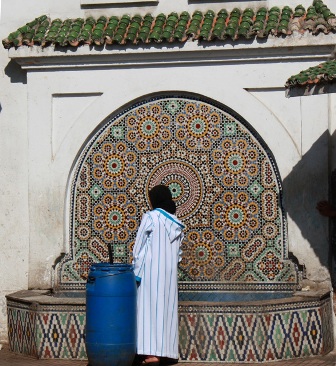
Fountain in Casablanca Medina

Fountain in Casablanca Medina
Read Next Episode: Fez
|
28 Sept 2009 Morocco (we are now in Fez) Coming from Paris to Morocco is not as much of a culture shock as it might have been. Morocco was a French protectorate from the early 20th C to 1958 and the legacy lingers on. The second language is French and there are cafes, patiseries and boulangeries on every corner, just like there are in Paris. English is studied by some as a third language in school but my bad French is being well used. The Moroccan version of Arabic, Darija, remains a mystery to us, both in the written and spoken version. Dress is a mixture of Western and Arabic style. Half of the women and men wear the jellaba, an ankle-length loose fitting robe with a pointy hood and silk knotted buttons down the front. The men favour a plain coloured jellaba and sometimes wear a small white cap. Wild patterns, especially African animal prints, are the choice of the women for their jellabas. Some women wear the hijab, a scarf that covers the hair, colour coordinated to their outfit, and some wear their hair loose. Only the very conservative women wear a face veil and even then the eyes are not covered. Shoes are either babouches, pointy-toed slippers, or the latest fashion western footwear. I think the Moroccans have learned to drive in Paris. Hundreds of tiny cars clog the streets, racing as fast as they can around the corners and round-abouts. There are a few traffic lights and cross walks but only the drivers can see the lights. We learned early on to stick close to a local and cross the street when they do. Our street crossing skills are improving. Sidewalk tables outside the cafes are filled all day with men drinking sweet mint tea or strong coffee and chatting to their friends. In the evening we spied men smoking hookah pipes inside some of the cafes. Women, except for tourists, are seldom part of the cafe scene. They are too busy going to work or shopping for the family. An evening visit to a patiserie is when you will find the women enjoying a snack with their friends or family. The evening is also the family shopping time. The streets are crowded with people strolling and shopping for the goods displayed in every shop window. Casablanca, the first city we visited, is full of art deco buildings built during the Colonial period. Some are in beautiful repair and some could do with a coat of paint. Several of the government buildings are decorated in the traditional style with intricately carved facades and richly coloured mosaics. We walked to the fishing port in Casablanca hoping to have lunch in a recommended seafood restaurant. It had been closed for Ramadan and was reopening the day after we left. Instead, we watched the fishermen, home from the nights fishing, repair their nets and sell their catch in a small market next to the crowded docks. We finally had our seafood lunch in Rabat, our second stop, in a popular restaurant right on the beach. We were entertained while eating watching boys ride surf boards and body boards through the impressive Atlantic Ocean breakers.
It is almost impossible not to get lost in the warren of alleys in the medina and we have discovered hidden gems while trying to figure out where we are. In Meknčs last Saturday, we took a side alley to find ourselves in a slightly wider area with a line of women standing in the middle. Each had an open bag at their feet overflowing with fabrics. Men carrying fabrics or carpets circled the women calling out their wares. They would stop and unroll a carpet or display their fabric for a likely customer. This was a weekly carpet and textile market and the women were from the neighbouring countryside. They buy the goods in the medina and return to their villages with new stock for their own shops.
Just 5 km from Volubilis is the hilltop town of Moulay Idriss. August finds hundreds of Muslim pilgrimages coming to worship at the tomb of Moulay Idriss, the founder of the first dynasty in Morocco. Our driver let us off at the base of the town and gave us time to explore on our own. We walked into the market area, as usual crowded with shoppers and donkeys waiting for loads to carry up the steep streets inaccessible to cars. A local stopped to give us advice as to the way to Moulay Idriss mausoleum and before we knew it, we had the services, unasked for, of a guide. He did lead us up to the best spot for a view and prevented us from getting lost but we ended up paying him for his services, although less than he had hoped. The lesson learned is to firmly insist you want to go on your own and not to express any thanks for unwanted advice. Oh well, everyone needs to earn a living and it is difficult in Morocco. We have been travelling from city to city by train since arriving in Casablanca and are now in Fez. We will stay here for a few days, exploring yet another medina, before setting off by bus further inland. There are more interesting towns to visit and we are looking forward to the rest of our trip. |
Return to Morocco Intro
Return to Travels
Return to Introduction